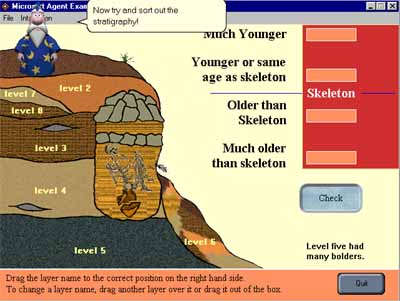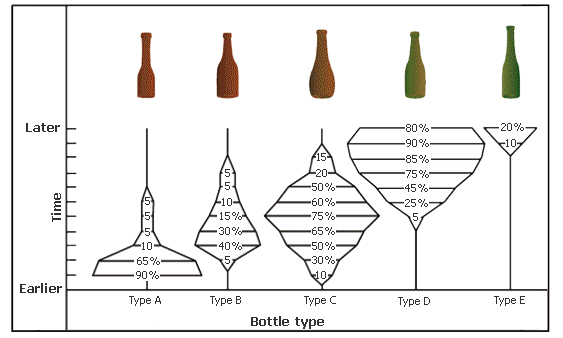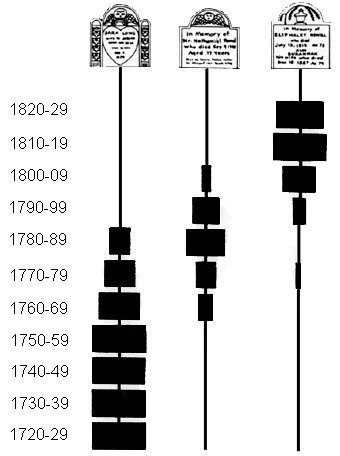
Anth 130 Introduction to Archaeology
Dr. Darlene Applegate
Fall 2007
Lab 2: Dating Methods
DATING METHODS
The dating of archaeological materials and sites is important in
addressing all academic goals of archaeology. In culture history,
dating is required to arrange past events into a chronological
sequence. In lifeways reconstruction, dating methods help to determine
which artifacts and sites are from the same time period. In culture
process, secure sequences of events are important in discerning
cause-and-effect relationships in culture change. Therefore,
archaeological dating relates directly to the first step of
archaeological research design: asking a question.
Archaeological dating itself is part of the seventh step of
archaeological research design: artifact analysis. Though dating may be
done while in the field, objects often are dated as part of
archaeological laboratory analyses. Archaeologists may select from
numerous dating methods depending on research question, the nature of
artifacts (e.g., material, context) or sites (e.g., stratified or
non-stratified), funding, and other factors. In this lab we will
consider three types of dating methods: stratigraphy, seriation, and
radiocarbon.
OBJECTIVES
- to apply the principles of stratigraphy to date layers at a
hypothetical archaeological site
- to apply the principles of seriation to order archaeological
sites into a chronological sequence
- to calculate radiocarbon dates
TERMS
- academic archaeology
- culture history
- lifeways reconstruction
- culture process
- archaeological research design
- stratigraphy
- strata (stratum, singular)
- midden
- superposition
- association
- contemporaneous
- cross-cutting relationship
- seriation
- stylistic attribute
- assemblage
- relative dating
- absolute / chronometric dating
- radiocarbon
- radioactive
- isotope
- radioactive decay
- half life
- parent element
- daughter element
STRATIGRAPHY
Stratigraphy is a relative dating method developed in geology and
applied frequently in archaeology. Using three stratigraphic
principles, soil strata and midden layers are placed into a
chronological sequence from oldest to youngest. Therefore, stratigraphy
is used to order events at one
particular archaeological site, if the site is stratified.
The law of superposition states that, in an undisturbed sequence of
strata, the oldest layers are on the bottom of the sequence and the
more recent layers on at the top of the sequence. The law of
association states that, in an undisturbed sequence of strata,
artifacts and other objects in a particular stratum are about the same
age or are contemporaneous. The law of cross-cutting relationships
states that any stratum or feature that cuts across another is younger
than that stratum.
For example, in the figure below the order of events, from oldest to
most recent, is given below.

level 6 deposited [older soil layers slumped down the
slope] (most recent)
level 1 deposited
level 2 deposited
level 7 deposited [this is level 4 soil that was dug from the grave pit]
level 8 deposited [this is level 3 soil that was dug from the grave pit]
grave feature excavated
level 3 deposited
level 4 deposited
level 5 deposited (oldest)
Image: http://www.meg.uct.ac.za/downloads/Aware/stratigr.htm
SERIATION
Seriation is a relative dating method developed by archaeologists. It
is based on changes in artifact assemblages or artifact stylistic
attributes: similar assemblages and styles should be close together in
time, while dissimilar assemblages and styles should be more separated
in time.
In the example below, stylistic variation in glass bottles is
illustrated. Note that the width of the curves represents the relative
frequency or abundance of each bottle type during a given time
interval. At the earliest time period, only Type A and Type C bottles
were used, with Type A (90%) being more common than Type C (10%). At
the latest time period, only Type D and Type E bottles were used, with
Type D being more common. This type of seriation chart can be used to
put archaeological sites with bottles into a chronological sequence.
For example, a site with 10% Type A, 40% Type B, and 50% Type C bottles
would be older than a site with 5% Type B, 20% Type C, and 75% Type D.

Image:
http://encarta.msn.com/media_461546925_761572159_-1_1/Seriation.html
RADIOCARBON
Radiocarbon is an absolute dating method that is based on the
radioactive decay of carbon-14. This is sometimes referred to as a
radiometric dating method. Radiocarbon is used to date organic-based
artifacts up to 100,000 years old. The date given by the radiocarbon
method is the date that the organism died, which is not necessarily
when the organism was used by humans; therefore, radiocarbon is an
indirect dating method.
Some carbon isotopes exist in unstable configurations and are referred
to as radioactive. The carbon-14 isotope, which has two extra neutrons
in the nucleus, is radioactive. It will undergo changes to become a
stable substance, nitrogen-14. The process of radioactive decay occurs
at a fairly constant rate that is expressed as a half life, or the time
it takes half of the radioactive or "parent" element to change into the
stable or "daughter" element. For carbon-14, the half life is 5730
years. Once the material becomes stable, it does not change any more.
After one half life, there will be half carbon and half nitrogen;
therefore, the ratio of carbon to nitrogen will be equal at 1/2 and 1/2
or 1:1.
After two half lives, half of the remaining carbon will be converted to
nitrogen; half of one-half is one-fourth, so the ratio of carbon to
nitrogen after two half lives will be 1/4 and 3/4 or 1:3.
After three half lives, half of the remaining carbon will be converted
to nitrogen; half of one-fourth is one-eighth, so the ratio of carbon
to nitrogen after three half lives will be 1/8 to 7/8 or 1:7. And the
process continues until the carbon is gone.
If we calculate the number of half lives that a specimen has gone
through, and we multiple that by the half life of carbon-14 of 5730
years, we can calculate the date when the organism died.
Age = number of half
lives * length of half life
ASSIGNMENT
Students may work in small groups in examining the items displayed in
the lab, but each student will complete his/her own answer sheet.
Answer sheets will be completed in pencil.
Stratigraphy
Examine the stratigraphic cross section of a hypothetical site provided
in the lab. Events represented in the cross section are deposition of
soil or midden layers, creation of cultural features, and construction
of structures. Using the principles of stratigraphy, arrange the events
into chronological sequence from oldest to most recent. Remember, the
oldest event is written on the bottom and the most recent event is
written at the top of the list.
Seriation
There are two seriation scenarios. In the first seriation problem,
stylistic variation in a particular type of artifact, tombstones in
this case, is used to arrange archaeological sites into a chronological
sequence. In the second seriation problem, chronological variation in
artifact assemblages is used to arrange archaeological sites into a
chronological sequence. List the chronological sequences of the sites
from oldest to youngest (left to right). Use the illustration below for
the first seriation problem.

Radiocarbon
There are four radiocarbon problems. In each problem, the amounts of
radioactive carbon and stable nitrogen are indicated in some format
(e.g., percentages, ratios, weights). Using that data, calculate the
number of half-lives the material has gone through. Then insert the
number of half lives into the radiocarbon formula to calculate the
radiocarbon date. Each answer should have units (years), but standard
deviations are not necessary.
Return to the Introduction
to
Archaeology
Home Page
Visit the Western Kentucky University Home Page, Western
Online
Page composed by Darlene Applegate, darlene.applegate@wku.edu
Last updated on August 28, 2007
All contents copyright (c), 2007. Western Kentucky
University.




